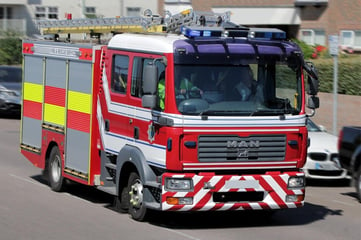New Resource: A Practical RAG Maturity Tool Shaped by the Blue Light User Group
At Head Light, we’re committed to ensuring that learning from the Blue Light sector is not just disc...

The growing external pressures on fire and rescue services are vast, with increasing operational demand not always matched by investment.
How can stretched fire and rescue services invest in their people?
Our head of business psychology was recently coaching the leader of the in-house fire and rescue service for a Middle Eastern energy company. She was struck by, not just the high-stakes and high-risk nature of the role, but also the very unique locations and environments within which he has to work and ensure the safety of hundreds of operatives.
In the course of the conversation, he talked passionately about the importance of instilling a safety mindset, of encouraging the right behaviours and how safety is not just a list of rules, policies and procedures – it needs to be embedded in the culture.
He talked about the role of leadership, of values and of training – and that he was proud to have completed some of his professional learning in the UK, as the UK Fire and Rescue Services are widely respected globally.
And certainly, respect is what we have felt whilst working with a number of fire and rescue services in the past three years.
The current challenges in fire and rescue are legion.
Concerns about rising temperatures, droughts and challenges with the urban-rural interface mean that services are needing to prepare for a continued increase in wildfires.
Incidents that require assistance from the fire services and collaboration with other agencies, have nearly trebled in a decade and now account for a third of non-fire calls.
Growing operational demand does not seem to be matched by levels of investment in our services, with services reporting infrastructure decay and chronic underfunding as significant barriers to service provision, and to preparation for forthcoming challenges. Many have seen staffing cuts and pauses on recruitment. Whilst the use of drones, thermal mapping tools and better PPE are helping services to be more adaptable and agile, the use of things such as AI risk analytics, AR interfaces and predictive models are still at an embryonic stage in the UK.
Following an inspection by HMICFRS in 2022, the 2023 report from the Inspectorate called out the need for culture change across fire and rescue services, with the following being some of the key findings (Source www.justiceinspectorates.gov.uk/hmicfrs, Values and Culture in Fire and Rescue Services. March 2023):
The 35 recommendations that followed include:
Implementing a Fire Service-specific 360: A Practical Solution
Whilst the National Fire Chiefs Council (NFCC) had a clear framework describing important leadership and management behaviours, there was no central provision for 360-degree feedback for fire and rescue services – and the College of Fire and Rescue (the parallel of the College of Policing) was the subject of a further recommendation and not yet in existence.
With our track record of supporting police forces in this area, it was at this point that we began working with fire and rescue, recognising that there was very little support or resource provided nationally.
Since then, we’ve been helping services to bed in a 360 process quickly and easily – based on the NFCC’s leadership behaviours – leveraging our experience of working in the blue light sector.
We also developed a sector specific set of 360 questionnaires for fire and rescue services that apply across ranks and grades.
Building Internal Coaching Capability
We’ve been continually impressed with the dedication, drive, openness and genuineness of the people we’ve worked with – both when having one-to-one coaching conversations with Fire Chiefs and senior leaders on the back of 360-degree feedback, and when training people to hold those conversations themselves. Many services have developed pools of coaches; managers, leaders, HR and L&D professionals who have trained and become accredited in coaching skills and have found time in their busy roles to offer support, guidance and a helpful ear to colleagues. A large number of those are adding 360 debriefs to their workload, but the value this can add is immeasurable.
Most services do not have the budget to buy in a volume of external consultancy time for these hugely important conversations, and internal staff carry the advantage of knowing the culture and the challenges faced, of being aware of the development opportunities and of knowing how to signpost those who need more help and support.
We can see the efforts that fire and rescue services are putting in to transforming their cultures and to grow the capability of their leadership, and we look forward to the outputs of the latest inspection programme.
Change takes time, but we hope that the improvements are starting to have a visible, measurable impact and we’re looking forward to supporting our amazing fire and rescue services into the future.
To explore how we might support your service, get in touch.
At Head Light, we’re committed to ensuring that learning from the Blue Light sector is not just disc...
As we approach 2026, we’re seeing several emerging and evolving priorities shaping how organisations...
Back in January, the College of Policing announced its National Talent Development Strategy (NTDS) t...